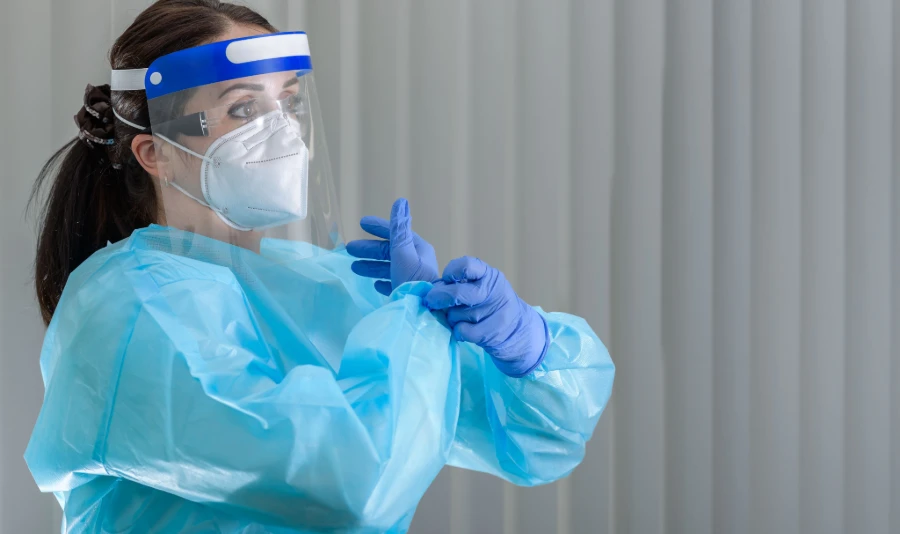The need for level 3 isolation gowns is growing. Healthcare and industrial buyers want safety and to follow rules. Buyers must pick gowns that protect well in risky places. Suppliers like INTCO help with infection control and meeting rules.
|
Aspect |
Details |
|---|---|
|
Market Size (2022) |
|
|
Projected Market Size (2030) |
USD 3,542.78 million |
|
CAGR (2023-2030) |
6.1% |
|
Protection Level Segmentation |
Level 3 gowns stop fluids and germs from getting through |
|
Demand Drivers |
Infection control rules, stricter laws, need for strong barriers |
|
Regional Growth |
Asia-Pacific grows fast as more hospitals open; Americas make more gowns at home |
|
Innovation & Trends |
New materials, smart fabrics, and eco-friendly ideas |
Level 3 Isolation Gown Standards
Compliance Requirements
Level 3 isolation gown standards tell people what to expect for safety. These rules help buyers pick gowns that block fluids and germs well. The ANSI/AAMI PB70:2012 standard is the main way to sort protective gowns. It has four levels, and level 3 means there is a moderate risk. Gowns at this level must pass tough tests for water resistance and strength.
|
Standard / Test |
Description / Requirement for Level 3 Isolation Gown |
|---|---|
|
ANSI/AAMI PB70:2012 |
Classification system for protective gowns; Level 3 indicates moderate risk. |
|
AATCC 42 Impact Penetration |
Spray impact water resistance test; Level 3 requires < 1.0 g spray impact. |
|
AATCC 127 Hydrostatic Pressure |
Hydrostatic pressure test; Level 3 requires > 50 cm water column resistance. |
|
ASTM F2407 |
Umbrella standard for surgical gowns including tear resistance, seam strength, lint generation, evaporative resistance, and water vapour transmission. Barrier testing aligns with ANSI/AAMI PB70 levels. |
|
ASTM F1670 and F1671 |
Tests for synthetic blood and viral penetration resistance, referenced under ASTM F2407. |
ASTM F2407-20 lists the physical and barrier needs for surgical gowns. It checks how strong the gown is, if it tears, and how well the seams hold. It also looks at lint and how water vapour moves through. Gowns must stop blood and viruses from getting through. These rules make sure a level 3 isolation gown keeps users safe from blood, body fluids, and germs.
Note: Level 3 isolation gowns work well for moderate-risk jobs. These include blood draws, putting in IV lines, emergency room care, and trauma cases. They give both comfort and protection, so many healthcare workers like them.
INTCO’s non-woven fabrics and gowns meet or beat these rules. The company uses new materials and smart ways to make gowns. INTCO tests its products a lot to make sure they follow ANSI/AAMI PB70 and ASTM F2407.
Regulatory Certifications
Regulatory certifications show a level 3 isolation gown is safe and high quality. The FDA says ANSI/AAMI PB70 is the main rule for liquid barrier safety. Makers must send 510(k) forms to the FDA with test results that prove they follow the rules. The FDA also wants drawings, labels showing the barrier level, and clear instructions.
Other important certifications are ISO 13485, which is about quality in making medical devices, and EN13795, which is for surgical drapes and gowns in Europe. These show a company uses strong quality checks and meets world safety rules.
- The ANSI/AAMI PB70 standard, accepted by the FDA, explains how to test and rate barrier protection, including level 3 gowns.
- The FDA asks makers to send 510(k) forms with test results that show they follow ANSI/AAMI PB70.
- Quality control uses Acceptable Quality Level (AQL) and Rejectable Quality Level (RQL) to make sure most gowns are good and few are bad.
- CDC rules say level 3 gowns are for moderate risk with blood and body fluids, and must block liquids and germs well.
- The FDA also requires Good Manufacturing Practices (GMP) and reports on medical devices, including when gowns let fluids through and may cause harm.
Materials & Quality
Fabric Types
Level 3 isolation gowns use special non-woven fabrics. These fabrics help keep people safe and comfortable. Makers pick different materials for each layer. Each material has its own job:
-
Spunbond Polypropylene (SPP):This is the outside layer. It is strong and keeps liquids out.
-
Meltblown (MB):This is the middle layer. It works like a filter to stop fluids and germs.
-
SMS (Spunbond-Meltblown-Spunbond):This fabric mixes spunbond and meltblown layers. It keeps out fluids and feels comfortable.
-
Film-Coated Fabrics:A plastic film covers these fabrics. The film adds more protection from liquids. These gowns are good for high-risk places.
INTCO uses these materials to make many non-woven products. Their technology makes sure every layer does its job. Some layers block germs, while others give comfort. INTCO makes gowns, masks, and other safety clothes. These are made for tough medical and work settings.
Barrier Performance
Barrier performance is very important for level 3 isolation gowns. The right fabric and design help stop fluids and germs. At the same time, they let air pass through. The table below shows how different gown fabrics compare:
|
Fabric Type |
Durability |
Breathability & Barrier Properties |
|---|---|---|
|
Reusable Gowns |
50+ washes |
Tight weave and chemicals block fluids but may trap heat |
|
Disposable Gowns |
One-time use |
Nonwoven layers are strong and block fluids; air flow depends on the fibres |
|
SMS Polypropylene |
One-time use |
Blocks fluids, germs, and viruses; stays comfortable |
|
Film-Coated Fabrics |
One-time use |
Stops liquids very well; may feel less airy; best for high-risk jobs |
INTCO’s SMS and film-coated gowns follow strict rules for blocking fluids and viruses. Their non-woven technology makes seams strong and gowns tough. Buyers should think about comfort, airflow, and how long gowns last. INTCO’s gowns balance these things well. That is why many people trust them for health and work needs.
Supplier Verification

Documentation
Buyers need to look at key papers before picking a supplier for a level 3 isolation gown. These papers show the gowns are safe and good quality. Here is what buyers should ask for:
-
CE mark on the gown and box, which means it follows EU rules.
-
Declaration of Conformity (DoC) with maker details and standards met.
-
Notified Body number by the CE mark, which you can check in the NANDO database.
-
Certificates for rules like EN 13795 and EN ISO 11607.
-
Sterilization details, including how it is done and proof for ISO 11135 or ISO 11137.
-
Technical files, like product info, specs, and test results.
Outside inspection groups, such as SGS, Intertek, TUV, or Bureau Veritas, often check these papers. Their reports help show the product is good and follows the rules. These steps keep buyers safe and help keep high safety levels.
Quality Assurance
Quality checks help buyers trust that suppliers give safe and good gowns. Auditing suppliers means looking at both how things are made and the final product. The table below lists common things checked in supplier audits:
|
Metric / Data Type |
Description / Use Case |
|---|---|
|
Statistical Process Control (SPC) |
Watches if products stay the same and if the process is steady. |
|
Certificate of Analysis (CoA) |
Shows test results and allowed ranges for each batch. |
|
Process Validation Data |
Proves that making the gowns stays within safe limits. |
|
CAPA Records |
Lists what is done to fix and stop problems. |
|
Product Conformity Data |
Check if products meet quality rules over time. |
|
Supplier On-Time Delivery |
Tracks how often suppliers deliver when they should. |
|
Raw Material Nonconformities |
Notes problems with materials that come in. |
|
Control of Nonconforming Materials |
Explains how bad materials are handled. |
|
Monitoring & Measurement of Product Release |
Makes sure products meet rules before shipping. |
|
Supplier Auditing |
Looks at risk, process controls, and fixing problems. |
Procurement Tips
Matching to Use
Picking the right gown keeps staff and patients safe. Buyers need to choose gowns that fit the jobs and risks in their workplace. Single-use gowns give steady protection and stay clean. They do not get worse after washing, unlike reusable gowns. Many workers like single-use gowns because they are simple to wear and throw away.
There are many gown styles and levels of protection. This helps buyers pick the best and cheapest gown for each job. The table below shows which gown to use for different tasks:
|
Protection Features |
Recommended Use Cases |
|
|---|---|---|
|
Level 1 |
Minimal fluid barrier; non-sterile |
Hospice care, care homes, low-risk wards |
|
Level 2 |
Enhanced fluid barrier; non-sterile |
Blood draws, suturing, ICUs, pathology labs |
|
Level 3 |
Sterile; moderate fluid barrier |
Arterial blood draws, IV insertions, emergency rooms, trauma care |
|
Level 4 |
Highest sterility and fluid barrier |
Fluid-intensive surgeries, with high pathogen resistance needed |
A level 3 isolation gown is best for medium-risk jobs. These jobs include emergency care and trauma work. Buyers should check the gown’s barrier rating and comfort before buying.
Common Pitfalls
Sometimes, teams make mistakes when buying lots of gowns. They may not match the gown level to the real risk. Some buyers only look at price and forget about quality or rules. Others do not check supplier papers or skip regular checks.
Tip: Always use a checklist when buying. Look at supplier certificates, test results, and delivery records. Keep checking suppliers to make sure they stay good.
Picking the right gown and supplier keeps everyone safe. Trusted brands like INTCO help buyers avoid mistakes and keep safety high.
When picking a level 3 isolation gown, buyers should use clear rules. They must check if the gowns follow the right standards. Buyers also need to look at how good the materials are. It is important to see if the supplier can be trusted. Big brands help meet large orders and keep gowns high quality.
FAQ
What does "Level 3" mean for isolation gowns?
Level 3 means the gown keeps out most fluids. It stops blood, body fluids, and germs in hospitals and factories. People pick Level 3 for jobs with more danger, like emergency care or trauma work.
Which materials work best for Level 3 isolation gowns?
Makers use non-woven fabrics such as SMS, SPP, and film-coated types. These fabrics block fluids and germs well. INTCO uses new non-woven methods to make gowns comfy, airy, and safe.
How can buyers verify supplier compliance?
Buyers should ask for certificates, test results, and labels. They can look for FDA 510(k), ISO 13485, and EN13795 papers. Reports from groups like SGS or TUV also help show the gowns are safe.
What is the most common mistake in gown procurement?
Many buyers only care about price and forget about quality or rules. They might not check supplier papers or pick the wrong gown level for the job. Using a checklist helps stop these mistakes.








